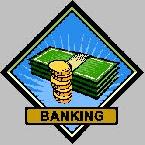
 |
|
| Financial Terms | |
| over-the-counter (OTC) |
|
Information about financial, finance, business, accounting, payroll, inventory, investment, money, inventory control, stock trading, financial advisor, tax advisor, credit.
Main Page: credit, tax advisor, financial advisor, inventory, payroll, accounting, investment, business, Also see related: condo, property, homebuying, first time homebuyer, mortgage, credit, home insurance, buy home, real estate, |
Definition of over-the-counter (OTC)
over-the-counter (OTC)Shares traded off an organized exchange.
Related Terms:Over-the-counter market (OTC)A decentralized market (as opposed to an exchange market) where Accelerated cost recovery system (ACRS)Schedule of depreciation rates allowed for tax purposes. Accounts receivable turnoverThe ratio of net credit sales to average accounts receivable, a measure of how Asset-coverage testA bond indenture restriction that permits additional borrowing on if the ratio of assets to Asset turnoverThe ratio of net sales to total assets. Cash flow coverage ratioThe number of times that financial obligations (for interest, principal payments, Counter tradeThe exchange of goods for other goods rather than for cash; barter.  Counterpart itemsIn the balance of payments, counterpart items are analogous to unrequited transfers in the CounterpartiesThe parties to an interest rate swap. Counterparty Partyon the other side of a trade or transaction. Counterparty riskThe risk that the other party to an agreement will default. In an options contract, the risk CoverThe purchase of a contract to offset a previously established short position. Coverage ratiosRatios used to test the adequacy of cash flows generated through earnings for purposes of Covered callA short call option position in which the writer owns the number of shares of the underlying Covered call writing strategyA strategy that involves writing a call option on securities that the investor Covered interest arbitrageA portfolio manager invests dollars in an instrument denominated in a foreign  Covered or hedge option strategiesStrategies that involve a position in an option as well as a position in the Covered PutA put option position in which the option writer also is short the corresponding stock or has Crossover rateThe return at which two alternative projects have the same net present value. Debt-service coverage ratioEarnings before interest and income taxes plus one-third rental charges, divided Doctrine of sovereign immunityDoctrine that says a nation may not be tried in the courts of another country Fixed asset turnover ratioThe ratio of sales to fixed assets. Fixed-charge coverage ratioA measure of a firm's ability to meet its fixed-charge obligations: the ratio of Forward coverPurchase or sale of forward foreign currency in order to offset a known future cash flow. Government bondSee: Government securities. Government National Mortgage Association (Ginnie Mae)A wholly owned U.S. government corporation Government sponsored enterprisesPrivately owned, publicly chartered entities, such as the Student Loan Government securitiesNegotiable U.S. Treasury securities. Interest coverage ratioThe ratio of the earnings before interest and taxes to the annual interest expense. This Interest coverage testA debt limitation that prohibits the issuance of additional long-term debt if the issuer's Inventory turnoverThe ratio of annual sales to average inventory which measures the speed that inventory Market overhangThe theory that in certain situations, institutions wish to sell their shares but postpone the OTCSee: over-the-counter. Overbought/oversold indicatorAn indicator that attempts to define when prices have moved too far and too Overfunded pension planA pension plan that has a positive surplus (i.e., assets exceed liabilities). Overlay strategyA strategy of using futures for asset allocation by pension sponsors to avoid disrupting the Overnight delivery riskA risk brought about because differences in time zones between settlement centers Overnight repoA repurchase agreement with a term of one day. OverperformWhen a security is expected to appreciate at a rate faster than the overall market. Overreaction hypothesisThe supposition that investors overreact to unanticipated news, resulting in OvershootingThe tendency of a pool of MBSs to reflect an especially high rate or prepayments the first time Oversubscribed issueInvestors are not able to buy all of the shares or bonds they want, so underwriters must Oversubscription privilegeIn a rights issue, arrangement by which shareholders are given the right to apply Portfolio turnover rateFor an investment company, an annualized rate found by dividing the lesser of Price discovery processThe process of determining the prices of the assets in the marketplace through the Rally (recovery)An upward movement of prices. Opposite of reaction. Receivables turnover ratioTotal operating revenues divided by average receivables. Used to measure how Risk loverA person willing to accept lower expected returns on prospects with higher amounts of risk. Roll overReinvest funds received from a maturing security in a new issue of the same or a similar security. RolloverMost term loans in the Euromarket are made on a rollover basis, which means that the loan is Sovereign riskThe risk that a central bank will impose foreign exchange regulations that will reduce or TakeoverGeneral term referring to transfer of control of a firm from one group of shareholder's to another Total asset turnoverThe ratio of net sales to total assets. TurnoverMutual Funds: A measure of trading activity during the previous year, expressed as a percentage of Uncovered callA short call option position in which the writer does not own shares of underlying stock Uncovered putA short put option position in which the writer does not have a corresponding short stock INVENTORY TURNOVERThe number of times a company sold out and replaced its average stock of goods in a year. The formula is: MACRS (Modified Accelerated Cost Recovery System)A depreciation method created by the IRS under the Tax Reform Act of 1986. Companies must use it to depreciate all plant and equipment assets installed after December 31, 1986 (for tax purposes). Bank overdraftMoney owed to the bank in a cheque account where payments exceed receipts. Non-production overheadA general term referring to period costs, such as selling, administration and financial expenses. OverheadAny cost other than a direct cost – may refer to an indirect production cost and/or to a non-production expense. Overhead allocationThe process of spreading production overhead equitably over the volume of production of goods or services. Overhead rateThe rate (often expressed per hour) applied to the time taken to produce a product/service, used to allocate production overheads to particular products/services based on the time taken. May be calculated on a business-wide or cost centre basis. Production overheadA general term referring to indirect costs. TurnoverThe business income or sales of goods and services. accounts receivable turnover ratioA ratio computed by dividing annual asset turnover ratioA broad-gauge ratio computed by dividing annual capital recoveryRefers to recouping, or regaining, invested capital over inventory turnover ratioThe cost-of-goods-sold expense for a given overhead costsoverhead generally refers to indirect, in contrast to direct, Fixed Assets Turnover RatioA measure of the utilization of a company's fixed assets to Fixed Charge Coverage RatioA measure of how well a company is able to meet its fixed Inventory Turnover RatioProvides a measure of how often a company's inventory is sold or Total Asset Turnover RatioA measure of the utilization of all of a company's assets to applied overheadthe amount of overhead that has been assigned to Work in Process Inventory as a result of productive activity; credits for this amount are to an overhead account asset turnovera ratio measuring asset productivity and showing the number of sales dollars generated by each dollar of assets fixed overhead spending variancethe difference between the total actual fixed overhead and budgeted fixed overhead; fixed overhead volume variancesee volume variance overapplied overheada credit balance in the overhead account overheadany factory or production cost that is indirect to overhead application ratesee predetermined overhead rate overhead efficiency variancethe difference between total budgeted overhead at actual hours and total budgeted overhead spending variancethe difference between total actual overhead and total budgeted overhead at actual predetermined overhead ratean estimated constant charge per unit of activity used to assign overhead cost to production or services of the period; it is calculated by dividing total budgeted annual overhead at a selected level of volume or activity by that selected measure of volume or activity; it is also the standard overhead application rate standard overhead application ratea predetermined overhead rate used in a standard cost system; it can be a separate variable or fixed rate or a combined overhead rate takeoverthe acquisition of managerial control of the corporation total overhead variancethe difference between total actual overhead and total applied overhead; it is the amount of underapplied or overapplied overhead underapplied overheada debit balance in the overhead account at the end of a period; when the applied overhead amount is less than the actual overhead that was incurred variable overhead efficiency variancethe difference between budgeted variable overhead based on actual input activity and variable overhead applied to production variable overhead spending variancethe difference between total actual variable overhead and the budgeted amount of variable overhead based on actual input activity Factory overheadAll the costs incurred during the manufacturing process, minus the Fixed overheadThat portion of total overhead costs which remains constant in size Modified Accelerated Cost Recovery System (MACRS)Depreciation method that allows higher tax deductions in early years and lower deductions later. CountercyclicalFalling during expansions and rising during recessions. A countercyclical policy stimulates during a recession and contracts during an expansion. Coverdell Education IRAA form of individual retirement account whose earnings OvertimeA pay premium of 50 percent of the regular rate of pay that is earned Rollover IRAAn IRA that an individual sets up for the express purpose of receiving Public Oversight BoardAn independent private-sector body that oversees the audit practices Inventory turnoverThe number of times per year that an entire inventory or a Related to : financial, finance, business, accounting, payroll, inventory, investment, money, inventory control, stock trading, financial advisor, tax advisor, credit. |